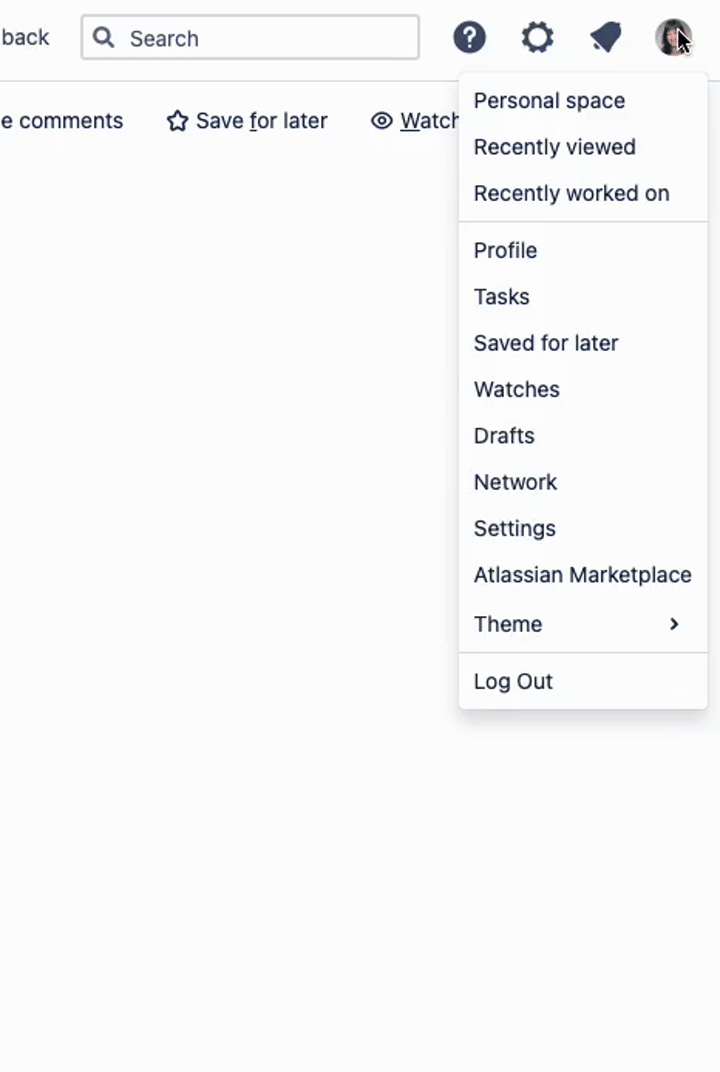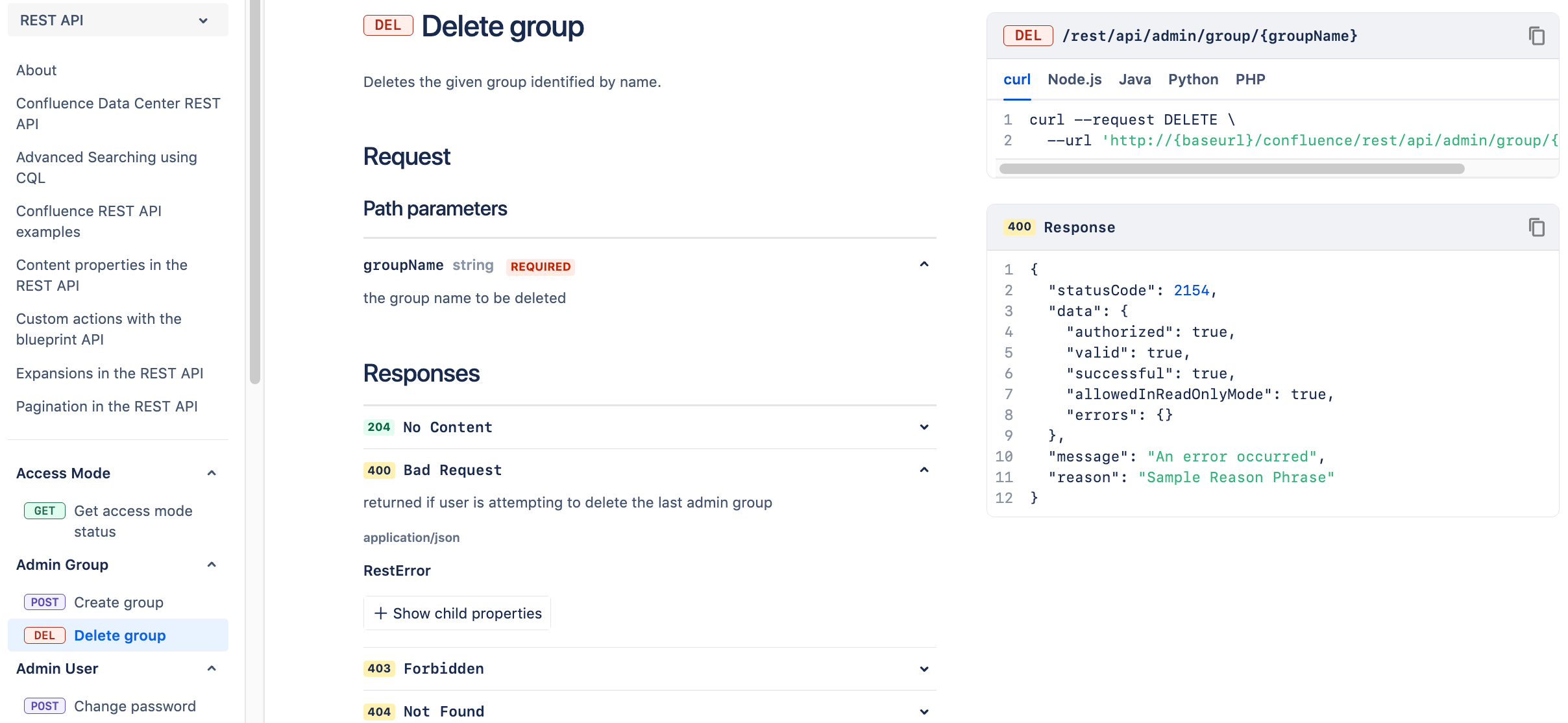Confluence 9.0 release notes
30 July 2024
We're excited to present Confluence 9.0Highlights
- Dark theme is here!
- Word count for pages and blogs
- Estimated page read time
- Images are now more accessible
- Improved Code Block macro security
- Front-end dependencies SBOM file included in the distribution
- Support for OpenSearch
- REST API documentation upgrade
- New default HTTP security headers
- New health check for improved backup security
- Almost out of user licenses? Get an early alert
- End of support for Java 11
- Support for Java 21
- Advance notice: take a peek!
This Confluence release supports only Data Center licenses. If you have a Server license, check out your options for upgrading.
More
Read the upgrade notes for important info about this release and see the full list of issues resolved.
Thanks for your feedback
More than 2308 votes satisfied!
Dark theme is here!
For: END USERS
We’re excited to bring you one of the most requested features from users everywhere: dark theme.
To enable dark theme, select your profile picture in the upper-right corner of the screen. Then, select Theme and Dark. Alternatively, if you’re already using dark theme as your system default, you can select Match system, and Confluence will automatically adjust to dark theme.
Animated screenshot: Enabling dark theme
Dark theme in Confluence delivers a fresh look to a familiar experience. We’ve updated the header navigation and made other changes to improve ease of use and accessibility.
Screenshot: Light theme header navigation
Screenshot: Dark theme header navigation
We also refreshed the text color and background color palettes in table cells to improve accessibility contrast. The new colors adjust depending on whether you’re viewing the page in light or dark theme.
Screenshot: Light theme text color palette
Screenshot: Dark theme text color palette
Theme options also include original and light. Although both themes represent the usual, lighter-colored user interface, they are slightly different from each other. Original theme presents the classic look and colors of Confluence prior to Confluence 9.0. We plan to remove original theme in a later release.
Confluence 9.0 has light theme set by default. It's the direct, lighter-colored alternative to dark theme. Both dark and light themes use the same design elements to give you a consistent experience when switching between themes.
We’d love you to try dark theme and share your thoughts with us on the feedback page.
Check out our guide on how to set up dark theme.
Word count for pages and blogs
For: END-USERS
Need to check that you’ve hit the minimum word requirement for your paper, or that you haven’t exceeded the maximum number of words for a proposal? Confluence is your friend!
The editor now keeps track of the number of words on your page or blog while you type, and displays either the total or selected number of words you have highlighted in the bottom toolbar.
Screenshot: Checking the number of words or characters
And if you need to count characters instead of words, the editor does that too. Just switch over using the dropdown - easily done!
Discover how to use the word count.
Estimated page read time
For: END-USERS
In today’s world, many of us read a lot of Confluence pages every day. To help you judge how long it will take to read a page, you’ll now see the estimated read time underneath the title of a page or blog. Use this insight to better plan your day and commit to reading the right pages, without the need to scroll. Estimated read time is currently based on a reading speed of 265 words per minute, which is common across many languages.
Explore how to check the estimated read time.
Screenshot: Estimated read time under the Confluence page title
Images are now more accessible
For: END-USERS
We’ve made more improvements to the accessibility of Confluence Data Center — specifically when interacting with images. Keyboard navigation and screen reader support now enable users to access image previews and the Insert files and images dialog. Moreover, elements within the dialog are now accessible, allowing users to select or deselect files, and to preview images.
Improved Code Block macro security
For: END-USERS ADMINS
As part of our ongoing improvements to platform security and performance, we've removed the Add New Language feature for adding custom languages from the Code Block macro.
If you haven’t installed any custom languages, this change won’t affect you.
If you’ve installed custom languages, they will stop working, and code blocks using them will revert to the default language. Java becomes the default for code blocks previously set to a custom language.
Note that this change was made in the recently released Confluence 8.9.4.
Front-end dependencies SBOM file included in the distribution
For: ADMINS
Previously introduced in Confluence 8.9, the SBOM file now supports both front-end and back-end dependencies starting with Confluence 9.0.3. The SBOM provides detailed information on software components, dependencies, and licenses used in the build process. This improvement ensures that the Confluence Data Center complies with the Secure Software Development Framework.
To locate the SBOM, go to the sbom/ folder in the Confluence installation directory. This folder contains the following three files:
atlassian-confluence-9.0.3-sbom.cdx.json
atlassian-confluence-9.0.3-sbom.csv
atlassian-confluence-9.0.3-sbom.spdx
Support for OpenSearch
For: ADMINS
Confluence now supports OpenSearch as an alternative search platform. There are several benefits you can expect when switching to OpenSearch:
Better performance - Faster search results put the information users need at their fingertips.
Scale with confidence - As your organization grows in size and scale, take advantage of OpenSearch’s horizontal scaling capabilities and let Confluence grow with you.
Reduced overhead - Simplified index management lowers overall Confluence resource consumption.
High availability - Search without interruption on clustered OpenSearch instances during reindexing.
In the user interface, the search experience remains the same for users.
At this point, OpenSearch is not Confluence’s default search platform, and you need to set up and configure it first before you’re ready to start using it.
Visit the OpenSearch configuration guide which contains external links to OpenSearch resources to help you get started.
REST API documentation upgrade
For: ADMINS
We’ve modernized the look and feel of our pre-Confluence 9.0 Data Center REST API documentation by migrating it to Swagger. In addition to the refreshed look and feel we’re getting from the Swagger API documentation framework, this migration will make our API docs easier for you to navigate, find examples, and copy snippets from.
Take a look at the new REST API appearance on developer.atlassian.com.
Screenshot: Updated look and feel of Confluence Data Center REST API
New default HTTP security headers
For: ADMINS
New default HTTP security headers have been implemented to enhance security measures against XSS and clickjacking attacks. With this change, all requests served by the system will automatically include new default HTTP security headers improving overall security connectivity when accessing Confluence through web browsers.
For more details, check out our Confluence 9.0 upgrade notes.
New health check for improved backup security
For: ADMINS
The Atlassian Troubleshooting and Support app (ATST) has been upgraded and equipped with a new check for Local Backup Security. This health check warns about any stored backups in Confluence’s file system, which may expose confidential data in the event of an attack.
Almost out of user licenses? Get an early alert
For: ADMINS
Keep track of your Confluence Data Center license seats with our new health check alert. It warns you as you approach your limit, giving you time to either upgrade your license or manage your user count. Additionally, you can customize this alert to notify you about a set number or percentage of available seats. By default, this is set to 10%.
For more details, explore how to set up a health check for Confluence license limit notifications.
End of support for Java 11
For: ADMINS
As previously announced, Java 11 is no longer supported.
You won’t be able to start Confluence 9.0 with Java 11.
You must use either Java 17 or 21 runtime to start Confluence 9.0.
Support for Java 21
For: ADMINS
You can now run Confluence with Java 21. Java 21 is a Long-Term Support version, so you’ll have several years of access to regular bug fixes and security updates.
In this release, we continue to bundle the Eclipse Temurin 17 JRE, but you can choose to switch to Java 21 now.
Explore our guide about switching your Java version or vendor.
Advance notice: take a peek!
Two-step verification in Confluence
For: ADMINS
We’re working on improving the security of our login experience for Confluence by allowing customers to add a second authentication layer.
The new login process will support a built-in two-step verification (2SV) capability using time-based one-time password (TOTP) as a second factor.
We’re happy to announce that we’re launching an Early Access Program (EAP) to seek feedback for the prototype of this solution and invite you to take part in this. See the recent Atlassian developer changelog entry for updates, useful links, and videos.
Resolved issues
For full details of bugs fixed and suggestions resolved, head to our public issues tracker on Jira.
Issues resolved in 9.0.3
Released on 03 September 2024
Issues resolved in 9.0.2
Released on 13 August 2024
Issues resolved in 9.0.1
Released on 30 July 2024
Get ready to upgrade
Platform releases allow us to incorporate multiple significant changes (often called “breaking changes”) that are not compatible with previous versions. These changes establish a strong foundation for more extensive development in future releases.
In this release, we’ve made significant changes in our core architecture to increase security and performance. Before upgrading, visit the Confluence 9.0 upgrade notes to review important upgrade steps and see the full list of issues resolved.
Been a while since your last upgrade? Check out our upgrade matrix for a bird's-eye view of the most important changes since Confluence 8.5 LTS.
Don't forget to renew your software maintenance. Renew now
Credits
Our wonderful customers...
You play an important role in making Confluence better. Thanks to everyone who participated in interviews with us, made suggestions, voted, and reported bugs!






